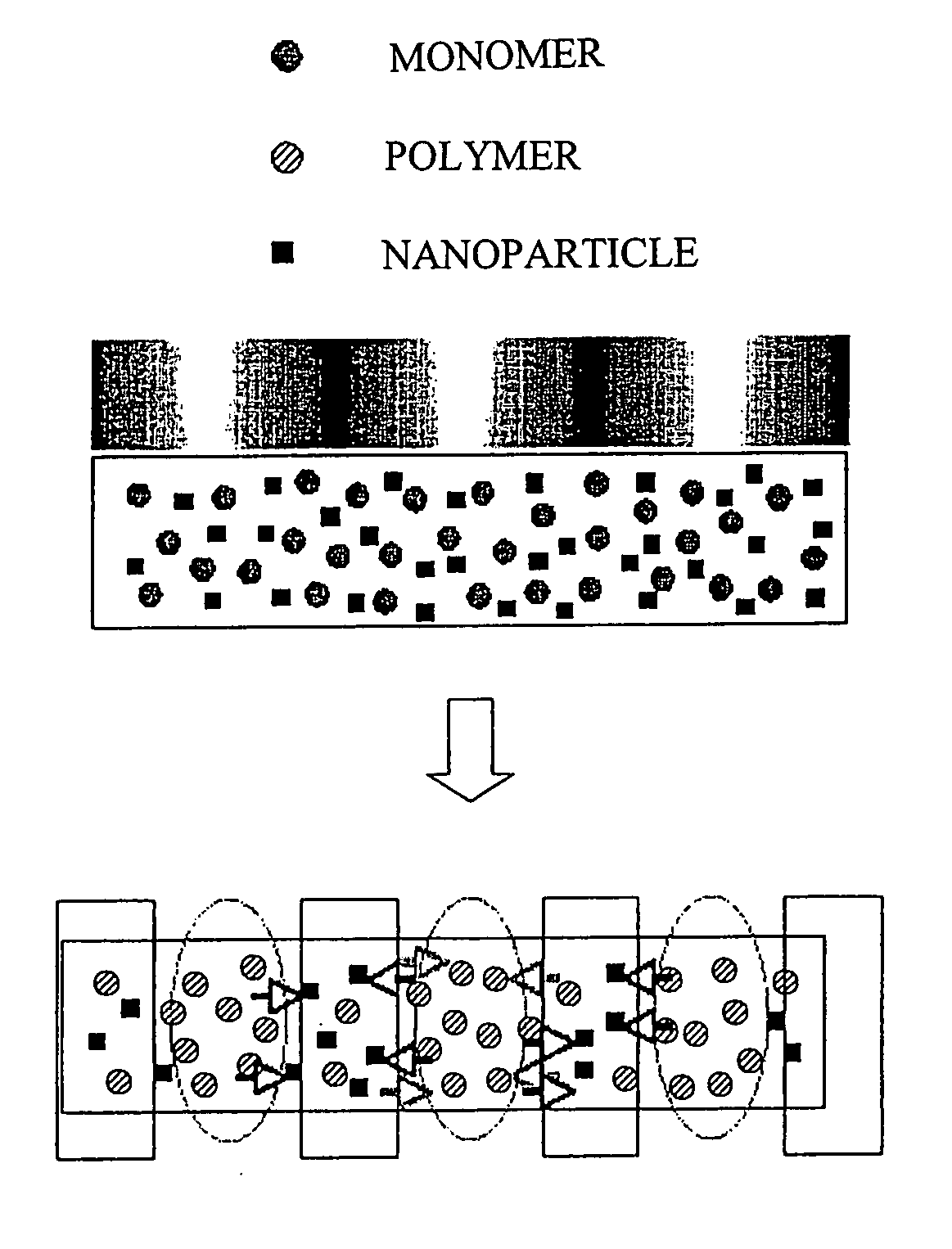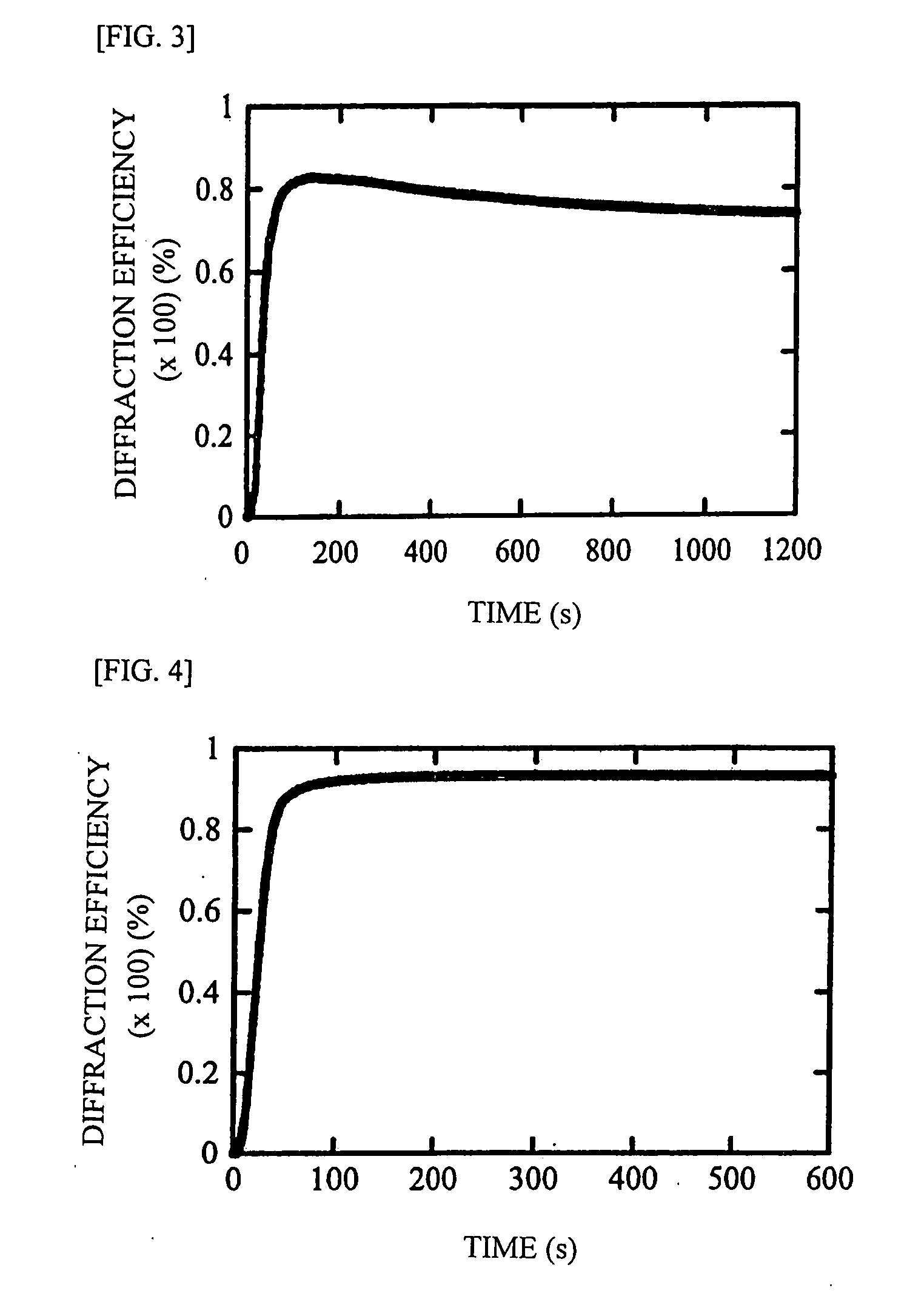Photosensitive Composition Containing Organic Fine Particles
a composition and organic technology, applied in the field of photosensitive compositions, can solve the problems of heat resistance and transparency, polymer is not mutually compatible, and the need for complex treatment during hologram creation, etc., to achieve high diffraction efficiency, low light scattering loss, and high degree of freedom
- Summary
- Abstract
- Description
- Claims
- Application Information
AI Technical Summary
Benefits of technology
Problems solved by technology
Method used
Image
Examples
example 1
Preparation of Photosensitive Composition
[0151]A photosensitive composition was prepared as follows. First, 0.1 g of organic fine particles, namely, hyperbranched polymers according to formula (1) (Nissan Chemical Industries, Ltd., trade name: OPTBEADS HPS-H) was dissolved in 0.253 g of toluene. Next, 0.212 g of a polymerizable compound, namely, tricyclodecane dimethanol dimethacrylate (Shin-Nakamura Chemical Co., Ltd., trade name: NK ESTER DCP) was added and homogeneously dispersed throughout. Then, 0.002 g of a photopolymerization initiator, namely, dicyclopentadienyl-titanium-bis(2,6-difluoro-3-(1 H-pyrrol-1-yl)-phenyl) (Ciba Specialty Chemicals Inc., trade name: IRGACURE 784) was subsequently dissolved.
[0152]A weight-average molecular weight Mw of 38,900 was measured for the hyperbranched polymer according to formula (1) by gel permeation chromatography relative to polystyrene standards, and the dispersity index Mw / Mn was 4.8.
[0153]The refractive index of the hyperbranched polym...
example 2
Preparation of Photosensitive Composition
[0159]A photosensitive composition was prepared as follows. First, 0.1 g of organic fine particles, namely, hyperbranched polymers according to formula (2) (Nissan Chemical Industries, Ltd., trade name: OPTBEADS HPEMA-H) was dissolved in 0.253 g of toluene. Next, 0.196 g of a polymerizable compound, namely, p-bis(β-methacryloyloxyethylthio)xylylene was added and homogeneously dispersed throughout. Then, 0.0022 g of a photopolymerization initiator, namely, dicyclopentadienyl-titanium-bis(2,6-difluoro-3-(1H-pyrrol-1-yl)-phenyl) (Ciba Specialty Chemicals Inc., trade name: IRGACURE 784,) was subsequently dissolved.
[0160]A weight-average molecular weight Mw of 36,100 was measured for the hyperbranched polymer according to formula (2) by gel permeation chromatography relative to polystyrene standards, and the dispersity index Mw / Mn was 2.2.
[0161]The refractive index of the hyperbranched polymer of formula (2) with respect to a 589-nm light waveleng...
example 3
Observation by Transmission Electron Microscope
[0166]A photosensitive composition was prepared according to the same method as used in Example 1. Hyperbranched polymers (Nissan Chemical Industries, Ltd., trade name: OPTBEADS HPS-H, weight-average molecular weight Mw: 38,900 and diffusion degree Mw / Mn: 4.9 as measured relative to polystyrene standards) were dispersed into a polymerizable compound, namely, p-bis(β-methacryloyloxyethylthio)xylylene, after which a photopolymerization initiator, namely, dicyclopentadienyl-titanium-bis(2,6-difluoro-3-(1H-pyrrol-1 -yl)-phenyl) (Ciba Specialty Chemicals Inc., trade name: IRGACURE 784) was added to obtain a photosensitive composition with 34 volume % of HPS-H. A volume phase type hologram recording medium was then produced from the composition using the same method as in Example 1, and a volume phase hologram was created according to the same method as in Example 1.
[0167]The obtained film was directly cut into thin sections with thicknesses ...
PUM
| Property | Measurement | Unit |
|---|---|---|
| refractive index | aaaaa | aaaaa |
| particle size | aaaaa | aaaaa |
| particle size | aaaaa | aaaaa |
Abstract
Description
Claims
Application Information
 Login to View More
Login to View More - R&D
- Intellectual Property
- Life Sciences
- Materials
- Tech Scout
- Unparalleled Data Quality
- Higher Quality Content
- 60% Fewer Hallucinations
Browse by: Latest US Patents, China's latest patents, Technical Efficacy Thesaurus, Application Domain, Technology Topic, Popular Technical Reports.
© 2025 PatSnap. All rights reserved.Legal|Privacy policy|Modern Slavery Act Transparency Statement|Sitemap|About US| Contact US: help@patsnap.com



